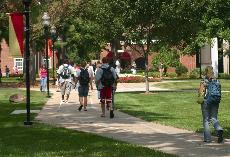We’ll Come Back

September 13, 2007
This fall, Barker and Kresge parking lots may hold fewer trunks laden with dirty laundry on Friday afternoons en route to a speedy trip back to mom and dad. That’s because Simpson has seen an increase in its out-of-state students. Out of a total of 385 freshmen with full-time enrollment, 61 students are from out of state.
John Bolen, registrar and associate academic dean, can’t help but note the increase in out-of-state students, as well as the effort put forth by the school for the change.
“Look at the percentage difference,” Bolen said, “because if you look at last year’s [total of] 412 [freshmen with full-time enrollment], only 46 of those were from out of state. As you can see, our percentage has gone up this year, a nice little jump. And that’s because there is a conscious effort on the part of the Admissions Department to try to attract more students form out of state.”
Admissions Counselor Tiffany Hummel, who travels out of Iowa to spread the word of Simpson to potential students, notes that the Admissions Office is in the process of stepping up its recruiting in states such as Florida, Arizona, Colorado, Texas, Minnesota and South Dakota. One of the biggest draws, according to Hummel, is the impression Simpson leaves on visiting out-of-state recruits.
“The most frequent compliment I hear from students about Simpson is [about] the campus appearance and atmosphere itself,” Hummel said. “One wouldn’t think high school students notice that very often when choosing a college, but it really does make a difference.”
Freshman Michael Holmes is one of those students. Even though his hometown of Snow Mass, Colo., is 1,000 miles away from the lush greens and maple leaves of Simpson, he is still glad he made the choice to come to school in Iowa, and, more specifically, to Simpson.
“I like the campus,” Holmes said. “I like the environment. I like the people here. I got accepted at Coe, Cornell and Simpson, all three that I applied to. But, in the end, I felt more comfortable at Simpson.”
Holmes is not the only freshman who feels content in his decision to attend Simpson despite the fact that a trip home requires more than just crossing a few county lines.
Freshman Sarah Silk, a native of Wilbraham, Mass., 1,300 miles away from campus, became interested in attending after hearing about the Music Department. For Silk, falling in love with Simpson came after the shock of the state’s scenery, but with an eventual appreciation for her surroundings.
“At first I was kind of skeptical,” Silk said. “I came off from the airport and as my mom and I were driving to Simpson, the only thing I could think of was ‘wow, so this Iowa…a lot of corn fields.’ But the campus was surprisingly different from what I pictured. It looked as if the college kind of plopped itself in the middle of a neighborhood while most schools are just surrounded by brick buildings.”
Bolen notes that there are a number of factors in Simpson administration’s interest in attracting more out-of-state students. One reason, he explains, is to benefit the students already at school who didn’t travel far to get here.
“It’s at least important because we need to have broader experience for our students here of different cultures and traditions from around the country,” Bolen said.
More than just diversifying Simpson’s overall student body, an interest in attracting more out-of-state students has a statistical draw. Bolen notes the very real implication a decline in the number of students in Iowa high schools will have on campus.
“The other reason for going out of state is because, one of these days, the number of high school graduates in Iowa is going to start to drop,” Bolen said, “and Simpson’s share of that will also drop. And so one of the ways that you hedge against losing too much ground is if you make sure that you have a good percentage of your incoming class from out of state, so that you’re not always relying on the high school graduation numbers from Iowa.”
Deb Tierney, vice president for enrollment, is also aware of the implications of the inevitable decline in Iowa’s high school graduates.
“Geographically, we are located in the center of a state that will experience a 6-percent decline in the number of high school graduates over the next 10 years,” Tierney said. “We expanded our recruitment efforts in out-of-state areas two years ago and we are delighted in the response we have had thus far.”
While Tierney notes that this year has drawn the fourth-largest freshmen class in history, Simpson has seen a slight decrease in its overall totals for full-time students, dipping from 1,524 students last year, to right around 1,507 this fall.
The main explanation for the drop, Bolen explains, is the large graduating class of last spring, which totaled 427 students.
Still, it seems Simpson can pride itself for its retention. This year, 1,041 full-time students are returning. Bolen notes that Simpson’s rates of retention outshine many state and community colleges in the area.
“Our retention numbers are really very strong among Iowa schools, certainly among private institutions,” Bolen said. “We’re way ahead of places like DMACC, Iowa State and University of Iowa and places like that. We’re almost double in retention. It’s just unbelievable.”
By combating the reality of a declining number of high school grads with goals of increasing out-of-state students, Bolen believes the college’s goals and rationale are well-aligned with the college’s overall purpose.
“We want to continue to grow in our quality,” Bolen said. “But do we see ourselves being 50 percent from Iowa, 50 percent from out of state? No. Why? That’s not who we are. Do we want to see the number of out of state students increase? Absolutely.”











